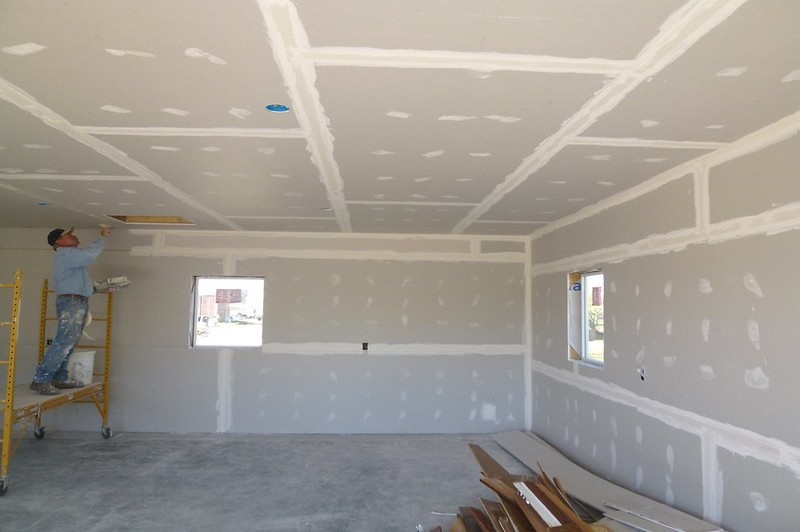Repairing your sheetrock due to prolonged water exposure is a task where you need knowledge on. Learn how to repair water damaged sheetrock as you read through this article!
Long water exposure can cause deformation and damages to your sheetrock, along with the growth of molds. Repairing and maintaining your sheetrock’s optimal state may be a challenge we can help you with.

Sheetrock is a drywall brand composed mainly of the same materials but with some extra chemicals and processes in construction. With the same material makeup, the process of installation and repair are mostly the same as well, but there are a few techniques that are more suitable to apply in sheetrock than the drywall.
DIY Steps In Fixing Water Damaged Sheetrock
Here’s all that you need to fix your water-damaged sheetrock on your own.
Step #1. Preparation
Preparation always comes first, so go and get yourself ready for the task at hand. Get your repair materials and safety pieces of equipment before you start working. This would save you the hassle as well as stress when working on your repairs.
Step #2. Assessment
Now that you are prepared and equipped, it’s time to proceed to the very first step of the repair. Assess the damage and where it came from. To ensure that your repair is worthwhile and long-lasting, you must first know where the root of the damage is and the level of damage you will be working on.
Water damage in your sheetrock may have come from leaks, and repairing those leakages will allow you to prevent future damage that can be attributed to that source. Deal with these sources first before proceeding to your sheetrock repair, or all your hard work will be for naught in the long run.
Step #3. Repair stage
Now that you know the level of damage and the source, after dealing with the source comes the repair stage of your DIY. If possible, take down the portion of the sheetrock that is water-damaged. Water-damaged sheetrock tends to sag or crumbles when you touch them and will be your identification on where you will be focusing on.
When you take down the damaged sheetrock, remember to wear your safety equipment, especially your mask and safety goggles. Place a trap or cloth in your working space so dust and other debris won’t litter around the area.
Now for the damaged part, mark the area of damage in a square shape. Remove the sheetrock along the original seams to be a frame guide for your replacement later on.
Measure the hole and cut the replacement a little bit wider and longer than the damaged portion that you will remove. About two inches will do.
Lay the replacement backside up and draw a line about an inch from the corners. Make sure the inside of the newly created line is the size of the damaged portion you removed.
From the backside, cut the outside of the line you made. Make sure no to cut the front-facing layer of paper. Peel the backside paper with a putty knife, place the replacement in the sheetrock’s removed portion, and apply a thin layer joining compound.
Using a putty knife, work the front-facing paper edge down into the sheetrock. Allow the compound to dry before applying a second layer.
After the replacement is in place, check if the seams are adequately filled. If not, then apply a filler or drywall mud and trim the excess off.
For water stain damages, just cut off the portion using a keyhole saw and replace the stained piece. If the damage is too extensive in the sheetrock for you to just trim, then it is better to replace the whole portion of that sheetrock.
Step #4. Finish up
Finish your repair work by applying a primer and repainting the sheetrock. The primer would allow the paint to stick easily and would help in preserving everything you work on for a longer time. At this point, your sheetrock is now repaired and is as good as new.
What is the difference between sheetrock and drywall?
Sheetrock and drywall are somewhat identical but differ in some aspects. First and foremost, sheetrocks are a brand of drywall.
Various types of drywall and sheetrock are designed for specific purposes, but the base production process of the two are almost identical. The slight difference is that sheetrocks are made with the help of a few extra chemicals and processes.
Can sheetrock be made waterproof?
Sheetrock as a type of drywall can be primed and waterproofed. There are various ways to waterproof both sheetrocks and drywalls using paint, sealants, and other stuff.
Some sheetrocks are made to be moisture resistant and are primarily used outdoors. As sheetrocks are easily subjected to the growth of molds, you must always look into waterproofing them as much as possible to avoid damages that may possibly harm your family.
Conclusion
After going with the DIY, we hope that you learned how to repair water damaged sheetrock at your very own home. Improving your home interior is a great skill to have as it provides a financial advantage on spending less on your repairs, but it can also give a sense of achievement you can’t buy anywhere else.
